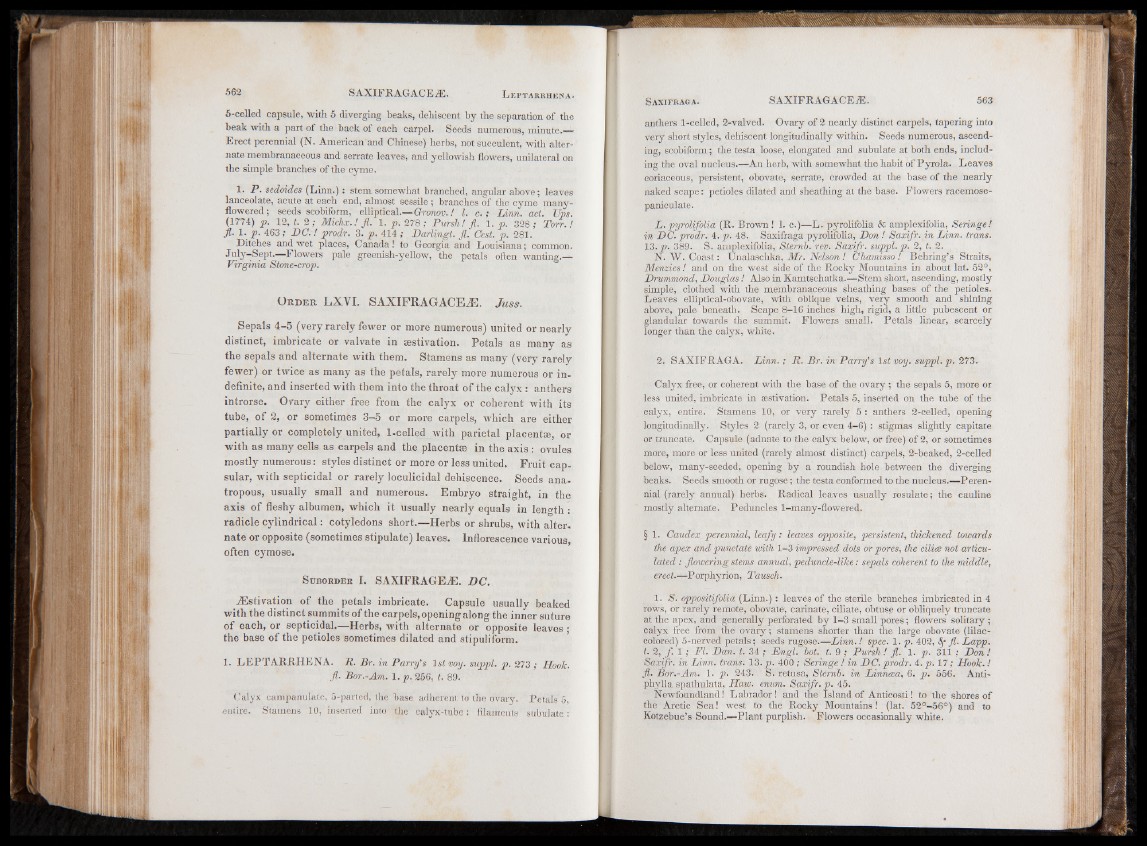
562 SAXIFRAGACEiE. L e pta rrh en a .
5-celled capsule, with 5 diverging beaks, dehiscent by the separation of the
beak with a part of the back of each carpel. Seeds numerous, minute.—
Erect perennial (N. American'and Chinese) herbs, not succulent, with alternate
membranaceous and serrate leaves, and yellowish flowers, unilateral on
the simple branches of the cyme.
1. P. sedoides (Linn.): stem somewhat branched, angular above; leaves
lanceolate, acute at each end, almost sessile ; branches of the cyme many-
flowered ; seeds scobiform, elliptical.—Gronov.! 1. c. ; Linn. act. Ups.
(1774) p. 12, t. 2 ; Michx.! fl. 1. p. 278 ; Pursh! fl. 1. p. 328 ; Torr. !
fl- 1- P- 463; DC. ! prodr. 3. p. 414 ; Darlingt. fl. Cest. p. 281.
Ditches and wet places, Canada! to Georgia and Louisiana; common.
July-Sept.—Flowers pale greenish-yellow, the petals often wanting.—
Virginia Stone-crop.
Order LXYI. SAXIFRAGACEiE. Juss.
Sepals 4-5 (very rarely fewer or more numerous) united or nearly
distinct, imbricate or valvate in aestivation. Petals as many as
the sepals and alternate with them. Stamens as many (very rarely
fewer) or twice as many as the petals, ra re ly more numerous or in definite,
and inserted with them into the throat of the calyx : anthers
introrse. Ovary either free from the calyx or coherent with its
tube, o f 2, or sometimes 3-5 or more carpels, which are either
partially or completely united, 1-celled with parietal placentte, or
with as many cells as carpels and the placentae in the axis : ovules
mostly numerous: styles distinct or more or less united. Fruit capsular,
with septicidal or rarely loculicidal dehiscence. Seeds ana-
tropous, usually small and numerous. Embryo straight, in the
axis o f fleshy albumen, which it usually nearly equals in length :
radicle cy lin d rica l: cotyledons short.—Herbs or shrubs, with alter,
nate or opposite (sometimes stipulate) leaves. Inflorescence various,
often cymose.
S uborder I. SAXIFR AGErE. DC.
^Estivation o f the petals imbricate. Capsule usually beaked
with the distinct summits of the carpels, opening along the inner suture
o f each, or septicidal.—Herbs, with alternate or opposite leaves *
the base of the petioles sometimes dilated and stipuliform.
1. LEPTARRHENA. R. Br. in Parry's 1st voy. suppl. p. 273 Hook,
fl. Bor.-Am. 1. p. 256, t. 89.
Calyx campanula^, 5-parted, the base adherent to the ovary. Petals 5,
entire. Stamens 10, inserted into the calyx-tube: filaments subulate:
anthers 1-celled, 2-valVed. Ovary of 2 nearly distinct carpels, tapering into
very short styles, dehiscent longitudinally within. Seeds numerous, ascending,
scobiform; the testa loose, elongated and subulate at both ends, including
the oval nucleus.—An herb, with somewhat the habit of Pyrola. Leaves
coriaceous, persistent, obovate, serrate, crowded at the base of the nearly
naked scape: petioles dilated and sheathing at the base. Flowers racemose-
paniculate.
L. pyrolifolia (R. Brown ! 1. c.)—L. pyrolifolia & amplexifolia, Scringe!
in DC. prodr. 4. p. 48. Saxifraga pyrolifolia, Don ! Saxifr. in Linn, trans.
13. p. 389. S. amplexifolia, Sternb. rev. Saxifr. suppl. p. 2, t. 2.
N. W. Coast: Unalaschka, Mr. Nelson! Chamisso ! Behring’s Straits,
Menzies! and on the west side of the Rocky Mountains in about lat. 52°,
Drummond, Douglas ! Also in Kamtschatka.—Stem short, ascending, mostly
simple) clothed with the membranaceous sheathing bases of the petioles.
Leaves elliptical-obovate, with oblique veins, very smooth and shining
above, pale beneath. Scape 8-16 inches high, rigid, a little pubescent or
glandular towards the summit. Flowers small. Petals linear, scarcely
longer than the calyx, white,
2. SAXIFRAGA. L in n .; R. Br. in Parry's 1st voy. suppl. p. 273.
Calyx free, or coherent with the base of the ovary ; the sepals 5, more or
less united, imbricate in estivation. Petals 5, inserted on the tube of the
calyx, entire. Stamens 10, or very rarely 5 : anthers 2-celled, opening
longitudinally. Styles 2 (rarely 3, or even 4-6) : stigmas slightly capitate
or truncate. Capsule (adnate to the calyx below, or free) of 2, or sometimes
more, more or less united (rarely almost distinct) carpels, 2-beaked, 2-celled
below, many-seeded, opening by a roundish hole between the diverging
beaks. Seeds smooth or rugose; the testa conformed to the nucleus.—Perennial
(rarely annual) herbs. Radical leaves usually rosulate; the cauline
mostly alternate. Peduncles 1-many-flowered,
§ 1. Caudex perennial, leafy: leaves opposite, persistent, thickened towards
the apex and punctate with 1-3 impressed dots or pores, the cilice not articulated
: flowering stems annual, peduncle-like: sepals coherent to the middle,
erect.—Porphyrion, Tausch.
1. $ . oppositifolia (Linn.) : leaves of the sterile branches imbricated in 4
rows, or rarely remote, obovate, carinate, ciliate, obtuse or obliquely truncate
at the apex, and generally perforated by 1-3 small pores; flowers solitary ;
calyx free from the ovary; stamens shorter than the large obovate (lilac-
colored) 5-nerved petals; seeds rugose.—Linn.! spec. 1. p. 402, fl. Lapp,
t. 2, ƒ. 1 ; Fl. Dan. t. 34 ; Engl. hot. t. 9 ; Pursh! fl. 1. p. 311; Don!
Saxifr. in Linn, trans. 13. p. 400 ; Seringe ! in DC. prodr. 4. p. 17; Hook.!
fl. Bor.-Am. 1. p. 243. S. retusa, Sternb. in Linncea, 6, p. 556. Anti-
phylla spathulata, Haw. enum. Saxifr. p. 45. ‘
Newfoundland! Labrador! and the Island of Anticosti! to the shores of
the Arctic S ea ! west to the Rocky Mountains! (lat. 52°-56°) and to
Kotzebue’s Sound.—Plant purplish. Flowers occasionally white.